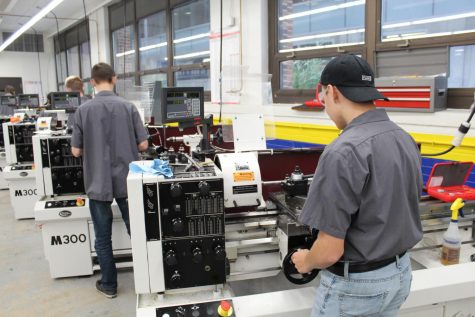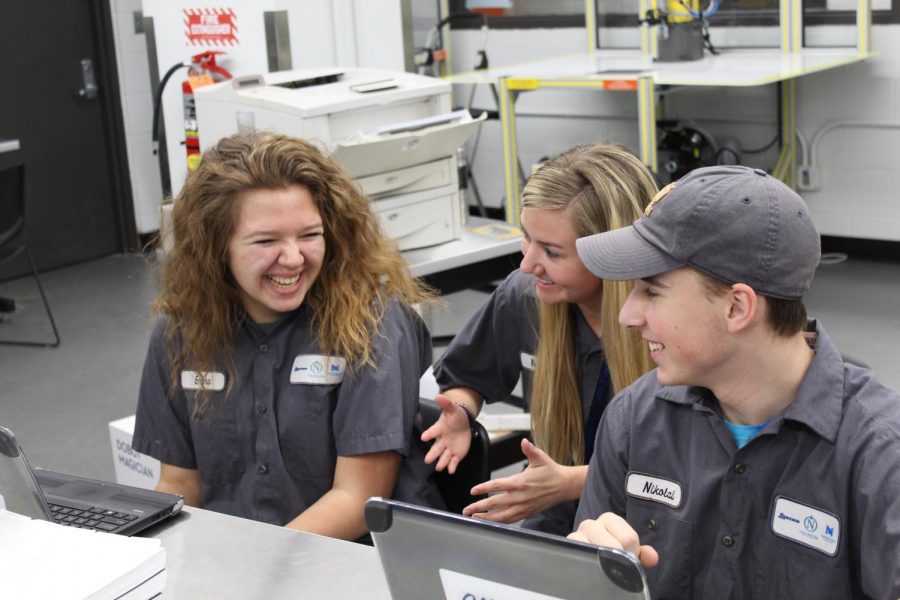Hands on learning leads to better education
Amanda Gutierrez, English teacher, discusses with Nick Knaizuk, 10, and Emma Stepanek, 10, what students like most about their Machine Tool 1-2 class. Photo by Zach Hansen
January 14, 2019
The benefit of a hands-on learning approach can be seen in an increasing number of programs, yet it isn’t implemented in enough areas to be as helpful as it could be. Many students who don’t learn very well from traditional lecture style teaching thrive in a project and hands on environment.
We need to have more of this style of teaching seen in the classroom. This would be an amazing addition to most any curriculum because it would help the students retain the information better while making it more enjoyable.
A study by Purdue University compared classes of eighth graders who had received a “traditional method” and those that had been given a project to demonstrate their understanding of the concept presented.
The study concluded that those that had completed the hands-on project instead of the traditional method of teaching had a better understanding of the subject. The study additionally showed that those students had shown an improved rate of comprehension between the start and end of the study.
“When he took classes down at the career center he would get straight A’s, he loved his classes, he loved his teachers,” said Gutierrez.
The career center is a great example of the effects of a more hands on approach to learning, because it has the materials to incorporate that style better. The Omaha Career Center can be seen at the TAC building on Cuming street.
Amanda Gutierrez, an English teacher at Omaha North, talked about her brother and how in a traditional learning environment he received “Mediocre grades at best.”Gutierrez’s brother didn’t like to sit still and he didn’t like to be talked at, he liked to do things.
“When he took classes down at the career center he would get straight A’s, he loved his classes, he loved his teachers,” said Gutierrez.
The career center provides many students the opportunity to learn something in a more specialized environment with teachers that are trained in their respective fields. It features classes from Automotive Technology to Welding. Each classroom is specialized for the subject it is assigned and features professional tools that would be seen in these areas of work.
The study had claimed that “In every area we tested, the students who were involved in a hands-on project learned more and demonstrated a deeper understanding of the issues than the traditional group.” The study had also claimed that “the book-and-lecture format may not be the best way to engage students in learning.”
A combination of these two would help both kinds of students. Those who learn better in lecture would still get that but they would be able to have a more applicable and tentative relationship with the subject at hand. Those who gather more from a hands on approach would get a better understanding of the subject through a better reference to what they’re doing which is added by the partial lecture format.
Gutierrez, who was substituting for Jeremy Wiemer at the time, said, “I wish we had had something like this when we were in school.”
Wiemer runs a portion of the shop here at Omaha North. While the career center may have many different options and certainly a multitude of tools for each respective field it does take up one class per day out of the four.
With this, many kids can’t spare room for these classes in their schedules, especially those that are taking honors and AP courses. But, for some this class is a must especially for those looking to get a degree in a very short amount of time. The North High School machining shop can get you a degree in machining through Metropolitan Community College.
The program starts students off with learning matching or manufacturing. During the first and second year of the program they will learn to use mills and lathes. In their third and final year they will learn how to program the automated CBC mills and lathes. After they have completed the high school portion they have the opportunity to do one year or less at Metro to get their degree and head into the workforce. If they pursue this they will be able to go into the highly skilled machining trades which is in high demand.
The program does not only teach machining though, it also teaches technical communications (an English class taught at north), safety class, blue printing, and CAD class.

Photo by Zach Hansen



